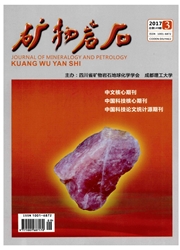

 中文摘要:
中文摘要:
用古生物和地球化学方法研究了准噶尔东北隅阿勒泰卡姆斯特地区下侏罗统三工河组地层中的紫红色放射虫硅质岩砾石,放射虫化石显示该种砾石所属硅质岩的地质年代为杜内期至维宪期早期,Fe/Ti-Al/(Al+Fe+Mn)和Fe2O3/TiO2-Al2O3/Al2O3+Fe2O3以及REE等地球化学特征反映该硅质岩沉积背景为局限小洋盆。据此推论克拉麦里洋盆封闭于早石炭世晚期,克拉麦里造山带在侏罗纪早期发生快速隆升。
 英文摘要:
英文摘要:
Located on the northeastern margin of Junggar basin, the Kelamaili orogenic belt was an important tectonic unit in central Asia geology. There was a controversy regarding its evolution history although a lot of work has carried out in the belt. Paleontology and geochemistry were used to study the radiolarian pebble of the Lower Jurassic Sangonghe Formation in the Kamusite area, northern Xingjiang. It was revealed that the radiolarians in the pebbles dated from Tournaisian to early Visean in age. Geochemical characteristics of the pebbles implied that the radiolarian was deposited in a small oceanic basin, indicating that Kelamaili oceanic basin was closed in the late Early Carboniferous and a quick uprising occurred in the Kelamaili orogenic belt during early Jurassic.
 同期刊论文项目
同期刊论文项目
 同项目期刊论文
同项目期刊论文
 期刊信息
期刊信息
